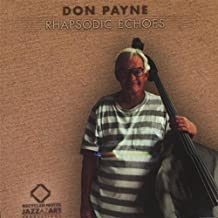
Daily Dose Of Jazz…
Donald Ray Payne was born on January 7, 1933 in Wellington, Texas but was raised in California, He initially played trumpet before switching to double bass in high school. His first major gigs came in the mid-1950s and he worked in the second half of the decade with Georgie Auld, Ornette Coleman, Maynard Ferguson, Calvin Jackson, Joe Maini, and Art Pepper.
1958 saw Don relocating to New York City, where he played with Tony Bennett, Chris Connor, and Mundell Lowe. He then joined Herbie Mann and Astrud Gilberto for international tours and also worked with Stan Getz around this time. He led his own ensemble with a rotating cast of sidemen, including Mike Abene, Joe Beck, and Gene Bertoncini.
Payne began playing bass guitar in 1964 and worked in popular and rock idioms as well as in jazz as a session musician for New York studio recordings. He played on releases by Loudon Wainwright III, Judy Collins, Roy Buchanan, Leonard Cohen (New Skin for the Old Ceremony, 1974), Janis Ian, Luiz Henrique, Harry Chapin, and Melanie Safka. His later jazz associations included Bobby Hackett, Jackie Cain, and Roy Kral.
Double bassist and bass guitarist Don Payne passed away on February 25, 2017 in Plantation, Florida. He was 84.
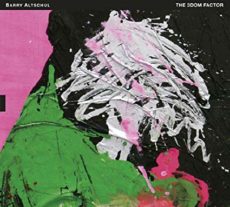
Daily Dose Of Jazz…
Barry Altschul was born on January 6, 1943 in New York City and having initially taught himself to play drums, studied with Charlie Persip during the 1960s. The free jazz and hard bop drummer first came to notice in the late 1960s when he performed with pianists Paul Bley and then he joined Chick Corea in 1969 with Dave Holland and Anthony Braxton to form the group Circle. At the time, he made use of a high-pitched Gretsch kit with add-on drums and percussion instruments.
By the 1970s, Altschul worked extensively with Anthony Braxton’s quartet featuring Kenny Wheeler, Dave Holland, and George Lewis. Braxton, signed to Arista Records, was able to secure a large enough budget to tour with a collection of dozens of percussion instruments, strings, and winds. In addition to his participation in ensembles featuring avant-garde musicians, Altschul performed with Lee Konitz, Art Pepper and other straight-ahead jazz performers.
Barry recorded thirteen albums from 1967 to 2015 but by the mid-Eighties, he spent most of his time in Europe, not becoming visible until 2000, performing with Billy Bang and Joe Fonda billing themselves as The FAB Trio. He also performed with the Jon Irabagon Trio, Adam Lane, Roswell Rudd, Dave Liebman, Barre Phillips, Denis Levaillant, Andrew Hill, Sonny Criss, Hampton Hawes, Annette Peacock, Sam Rivers, Julius Hemphill, Lee Konitz and numerous others in both the avant-garde and straight-ahead genres. The free jazz and hard bop drummer continues to perform and record.
More Posts: bandleader,drums,history,instrumental,jazz,music
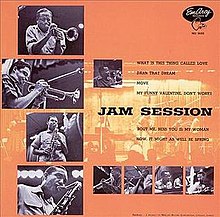
Requisites
Jam Session is the first of two albums that comprised a two-part EmArcy Jazz Series recorded in front of a live audience on August 14, 1954, in Los Angeles, California.
Track Listing | 46:47- What Is This Thing Called Love? (Cole Porter) – 14:56
- Darn That Dream (Eddie DeLange, Jimmy Van Heusen) – 5:16
- Move (Denzil Best) – 14:28
- My Funny Valentine/Don’t Worry ’bout Me/Bess, You Is My Woman Now/It Might as Well Be Spring (Lorenz Hart, Richard Rodgers/Rube Bloom, Ted Koehler/George Gershwin, Ira Gershwin/Oscar Hammerstein II, Rogers) – 11:29
- Clifford Brown, Maynard Ferguson, Clark Terry ~ trumpet Herb Geller ~ alto saxophone (1,3,4)
- Harold Land ~ tenor saxophone
- Junior Mance (1,3,4), Richie Powell (2) ~ piano
- Keter Betts, George Morrow ~ bass
- Max Roach ~ drums
- Dinah Washington ~ vocal (2)
The album is opened with a spirited introduction by Roach preceding the ensemble presenting the melody collectively of Cole Porter’s 1929 classic What Is This Thing Called Love? written for the Broadway musical, Wake Up and Dream. Clifford is up first, revealing a musical maturity far beyond his years on the opening statement with a solo of dynamic energy. Land endows the next solo with long, flowing lines as Terry strolls in with his third performance for an impressive and entertaining interpretation.
Geller demonstrates the smooth, melodic quality of his playing with a light, fluid tone on the fourth reading and Morrow takes over illustrating his agility and potent endurance. Ferguson maintains the interpretative intensity and fullness of tone with Roach’s tower of strength swinging relentlessly. Powell takes the final bow hitting a perfect groove with plenty of incandescent heat. This is how the album flows.
Dinah Washington makes her only appearance on the album with the 1939 Jimmy Van Heusen and Eddie DeLange popular ballad, Darn That Dream. The song was introduced in the Broadway musical, Swingin’ The Dream, also released in 1939. Dinah’s luscious lyric delivery is with exquisite softness and elegant phrasing into a gorgeous finale to end the first side. Though only appearing once on this album, Washington recorded its companion Dinah Jams the following night as part of the same series. Both are enjoyable at any time of the day or evening with something to offer most jazz tastes.
Source: Jazztracks by Eddie Carter | Excerpt: 12/2018 | atlantaaudioclub.org
More Posts: choice,classic,collectible,collector,history,instrumental,jazz,music
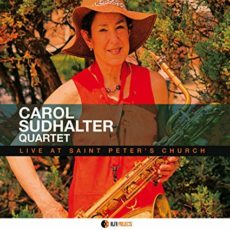
Daily Dose Of Jazz…
Carol Stearns Sudhalter was born on January 5, 1943 in Newton, Massachusetts and grew up in a musical family. Her father Albert played the alto saxophone in the New England area, a brother played baritone saxophone and one brother who played trumpet, cornet and wrote award-winning books on jazz.
In the early Sixties, Sudhalter began to play the flute while majoring in biology at Smith College. She continued to study flute with private teachers in Washington DC, New York, Boston, Israel, and Italy until 1978. She studied theory and Third Stream music with Ran Blake and Phil Wilson at the New England Conservatory of Music. From the 1970s on she has been teaching piano, saxophone, and flute privately, at Mannes College, and for the New York Pops Salute to Music Program.
1975 saw Carol deciding to take up the saxophone, and by 1978 relocated from Boston to New York City to join the first all-women Latin band, Latin Fever, produced by Larry Harlow. In 1986 she founded the Astoria Big Band, and she has performed with Sarah McLawler, Etta Jones, Chico Freeman, Jimmy McGriff, Duffy Jackson, and others around the New York jazz clubs, as well as domestic, Italian and British jazz festivals.
She initiated the Jazz Monday concerts at Athens Square Park between 1989 and 2001, along with several other local festivals in Queens where she resides.
A member of the Jazz Journalists Association, Sudhalter also has a chapter in Leslie Gourse’s Madame Jazz and in W. Royal Stokes’ Growing Up With Jazz. In 2012 she was nominated for the 2012 International Down Beat Readers’ Jazz Poll, and was voted 9th place in the category “Best Jazz Flutist”. She has recorded eight albums as a leader, one as a sideman, and the tenor and baritone saxophonist, flutist and pianist Carol Sudhalter continues to perform and educate.

More Posts: bandleader,composer,flute,history,instrumental,jazz,music,piano,saxophone
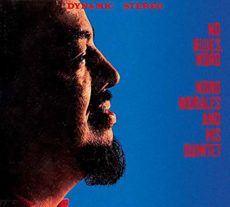
Daily Dose Of Jazz…
Norosbaldo Morales was born in Puerta de Tierra, Puerto Rico on January 4, 1912. The pianist learned several instruments as a child, playing in Venezuela from 1924 to 1930, then returned to Puerto Rico to play with Rafaél Muñoz.
Emigrating to New York City in 1935, Noro played there with Alberto Socarras and Augusto Cohen. By 1939, he and brothers Humberto and Esy put together the Brothers Morales Orchestra. He released the tune Serenata Ritmica on Decca Records in 1942, which catapulted him to fame in the mambo and rhumba music world; his band rivaled Machito’s in popularity in New York in the 1940s. It was during this time that his orchestra played for the Havana Madrid nightclub.
1960 saw Morales returned to Puerto Rico and play locally, working with Tito Rodríguez, José Luis Moneró, Chano Pozo, Willie Rosario and Tito Puente. Among the musicians who played in Morales’ orchestra were Ray Santos, Jorge López, Rafí Carrero, Juancito Torres, Pin Madera, Ralph Kemp, Pepito Morales, Carlos Medina, Lidio Fuentes, Simón Madera, Ana Carrero, Pellin Rodriguez, and Avilés.
The height of his fame and record production was his production of rumba records with his sextet, done after he gave up the big band idea. His use of the piano as both melody and rhythm was highly innovative at the time. Linda Mujer, Campanitas de Cristal, Perfume de Gardenias, Me Pica La Lengua and Silencio, all songs composed by others, were four of his big successes in this line.
Pianist and bandleader Noro Morales passed away on January 15, 1964 in San Juan, Puerto Rico at age 53.
More Posts: bandleader,history,instrumental,jazz,music,piano


